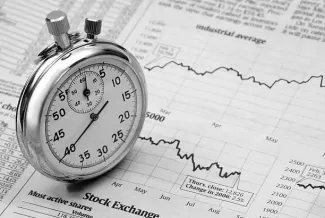
Why Patience Beats Perfection: The Long-Term Investor's Guide to Market Timing
Over your investing life, you’ll see markets swing between lows and highs. Financial headlines tend to amplify those extremes—especially when stocks hit new records, like “Stocks Hit Record Highs. What’s Behind the Rally?”
All-time highs can stir a very human reaction: a voice in your head urging, “Wait for a better entry point.” After all, everyone wants to buy low and sell high. But decades of data tell a different story—waiting for the perfect moment often costs more than it saves.
The Myth of Market Timing
It’s tempting to hesitate when markets are at record levels. No one wants to be the person who “bought at the top.” But this thinking overlooks a key reality: market highs aren’t rare—they’re normal.
Since 1950, the S&P 500 has closed at more than 1,250 all-time highs—an average of 16 new records each year. If you stayed out every time the market hit a new high, you’d spend much of your investing life on the sidelines, missing growth opportunities along the way.
What History Really Says About “Bad” Timing
Worried that buying after a high means you’re destined for a drop? History suggests otherwise. When the S&P 500 hit a new record in January 2024—its first in over two years—it followed a significant rebound from the 2022 downturn. Looking back at 13 similar instances since 1958 where markets reached a new high after at least a year of lower prices, the results were telling:
1 year later: Positive in 12 of 13 cases, with an average gain of 15.3%
2 years later: Higher in 11 of 13 cases, with an average return of 23%
While past performance can’t predict the future, history shows that new highs have rarely been a reason to avoid investing—and have often marked the continuation of long-term growth.
The Real Cost of Waiting
Delaying an investment because “prices are high” is like waiting to fill your gas tank until prices drop—you might save a little, but you risk stalling your journey.
Markets don’t ring a bell before rising or falling. Investors who wait for a significant pullback often end up chasing performance instead of benefiting from it. The opportunity cost of sitting in cash can outweigh the potential benefit of timing your entry perfectly.
Building a Patient Investment Strategy
Long-term investing success doesn’t hinge on predicting the next move—it’s about staying invested through all market cycles.
Three principles to keep in mind:
Consistency beats timing. Invest regularly, even during uncertainty, to reduce the pressure of picking the “right” moment.
Your time horizon matters. The longer you invest, the less impact any single entry point will have.
Diversify wisely. Spreading investments across asset classes won’t eliminate risk, but it can help manage it.
Ignore the Timing Temptation
Market timing feels logical, but it’s notoriously hard to execute. History has favored those who focus on time in the market over timing the market.
Patience—not perfection—has proven to be the more reliable path to building wealth. Your future self will likely thank you for staying the course.
Disclaimer: This content is for educational purposes only and should not replace personalized financial advice. Consult with a qualified financial professional to discuss your specific situation.
Sources:
Barron’s, 2025 [URL: https://www.barrons.com/articles/stock-market-hits-record-highs-tax-bill-jobs-6f818d48]
Bloomberg, RBC GAM, 2024 [URL: https://www.rbcgam.com/en/ca/learn-plan/investment-basics/investing-at-all-time-highs/detail]
Forbes, 2024 [URL: https://www.forbes.com/sites/wesmoss/2024/01/31/what-an-sp-500-all-time-high-could-mean-for-your-investments/]

